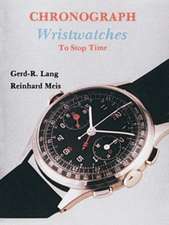Microsystems for Enhanced Control of Cell Behavior: Fundamentals, Design and Manufacturing Strategies, Applications and Challenges: Studies in Mechanobiology, Tissue Engineering and Biomaterials, cartea 18
Editat de Andrés Díaz Lantadaen Limba Engleză Hardback – 7 apr 2016
| Toate formatele și edițiile | Preț | Express |
|---|---|---|
| Paperback (1) | 1103.95 lei 6-8 săpt. | |
| Springer International Publishing – 20 apr 2018 | 1103.95 lei 6-8 săpt. | |
| Hardback (1) | 1111.09 lei 6-8 săpt. | |
| Springer International Publishing – 7 apr 2016 | 1111.09 lei 6-8 săpt. |
Din seria Studies in Mechanobiology, Tissue Engineering and Biomaterials
- 5%
 Preț: 681.26 lei
Preț: 681.26 lei - 18%
 Preț: 1121.76 lei
Preț: 1121.76 lei - 5%
 Preț: 1107.94 lei
Preț: 1107.94 lei - 5%
 Preț: 1103.22 lei
Preț: 1103.22 lei - 5%
 Preț: 724.50 lei
Preț: 724.50 lei - 5%
 Preț: 1100.30 lei
Preț: 1100.30 lei - 5%
 Preț: 715.35 lei
Preț: 715.35 lei - 5%
 Preț: 727.97 lei
Preț: 727.97 lei - 5%
 Preț: 719.02 lei
Preț: 719.02 lei - 5%
 Preț: 733.46 lei
Preț: 733.46 lei - 5%
 Preț: 725.42 lei
Preț: 725.42 lei - 5%
 Preț: 1095.73 lei
Preț: 1095.73 lei - 5%
 Preț: 1166.13 lei
Preț: 1166.13 lei - 5%
 Preț: 729.82 lei
Preț: 729.82 lei - 5%
 Preț: 1095.16 lei
Preț: 1095.16 lei - 5%
 Preț: 721.77 lei
Preț: 721.77 lei - 5%
 Preț: 1292.67 lei
Preț: 1292.67 lei - 18%
 Preț: 951.29 lei
Preț: 951.29 lei - 5%
 Preț: 1094.44 lei
Preț: 1094.44 lei - 5%
 Preț: 1109.23 lei
Preț: 1109.23 lei - 5%
 Preț: 714.27 lei
Preț: 714.27 lei - 5%
 Preț: 1093.35 lei
Preț: 1093.35 lei - 5%
 Preț: 1102.10 lei
Preț: 1102.10 lei - 5%
 Preț: 1107.21 lei
Preț: 1107.21 lei
Preț: 1111.09 lei
Preț vechi: 1169.56 lei
-5% Nou
Puncte Express: 1667
Preț estimativ în valută:
212.60€ • 221.98$ • 175.96£
212.60€ • 221.98$ • 175.96£
Carte tipărită la comandă
Livrare economică 04-18 aprilie
Preluare comenzi: 021 569.72.76
Specificații
ISBN-13: 9783319293264
ISBN-10: 3319293265
Pagini: 470
Ilustrații: XVII, 454 p. 175 illus.
Dimensiuni: 155 x 235 x 27 mm
Greutate: 0.84 kg
Ediția:1st ed. 2016
Editura: Springer International Publishing
Colecția Springer
Seria Studies in Mechanobiology, Tissue Engineering and Biomaterials
Locul publicării:Cham, Switzerland
ISBN-10: 3319293265
Pagini: 470
Ilustrații: XVII, 454 p. 175 illus.
Dimensiuni: 155 x 235 x 27 mm
Greutate: 0.84 kg
Ediția:1st ed. 2016
Editura: Springer International Publishing
Colecția Springer
Seria Studies in Mechanobiology, Tissue Engineering and Biomaterials
Locul publicării:Cham, Switzerland
Cuprins
Some introductory notesto cell behavior.- Brief introduction to the field of biomedical microsystems.- Briefintroduction to bio-microsystems for interacting with cells.- Common bioengineering resources for interacting with cells.- Methodologiesfor the development of bio-microsystems.- Addressing the complexity ofbiomaterials by biomimetic CAD.- Multi-scale andmulti-physical/biochemical modeling in bio-MEMS.- Rapid prototyping ofbio-MEMS for interacting with cells.- Nanomanufacturing for biomedicalMEMS.- Issues linked to the mass-production of biomedical microsystems.- Biomedicalmicrosystems for disease management.- Overview of microsystems forstudying cell behavior under culture.- Microsystems forstudying cell adhesion, dynamics and and overallmechanobiology.- Smart microsystems for active cell culturetoward relevant tissues.- Tissue engineering scaffolds for 3D cellculture.- Tissue engineering scaffolds for bone repair: General aspects.- Tissueengineering scaffolds for bone repair: Dental repair.- Tissue engineeringscaffolds for repairing soft tissues.- Tissue engineering scaffolds forosteochondral repair.- From labs-on-chips to microfluidic cell culture.- Cell-basedsensors and cell-based actuators.- Towards reliable organs-on-chips andhumans-on-chips.- Towards effective and efficient biofabricationtechnologies.- Project-based learning in the field of biomedicalmicrosystems.- Annexes.
Notă biografică
Andrés Díaz Lantada is Associate Professor at Technical University of Madrid (UPM), Spain, teaching 'Design and manufacture with polymers', 'Computer-aided engineering', and 'Bioengineering. He carries out research at the UPM Product Development Laboratory linked to the development of biomedical devices based on smart/multifunctional materials, biomimetic fractal and non-Euclidean designs, and mechanical metamaterials for enhanced performance and adequate tissue interaction.
Textul de pe ultima copertă
This handbook focuses on the entire development process of biomedical microsystems that promote special interactions with cells. Fundamentals of cell biology and mechanobiology are described as necessary preparatory input for design tasks. Advanced design, simulation, and micro/nanomanufacturing resources, whose combined use enables the development of biomedical microsystems capable of interacting at a cellular level, are covered in depth. A detailed series of chapters is then devoted to applications based on microsystems that offer enhanced cellular control, including microfluidic devices for diagnosis and therapy, cell-based sensors and actuators (smart biodevices), microstructured prostheses for improvement of biocompatibility, microstructured and microtextured cell culture matrices for promotion of cell growth and differentiation, electrophoretic microsystems for study of cell mechanics, microstructured and microtextured biodevices for study of cell adhesion and dynamics, and biomimetic microsystems (including organs-on-chips), among others. Challenges relating to the development of reliable in vitro biomimetic microsystems, the design and manufacture of complex geometries, and biofabrication are also discussed.
Caracteristici
Offers a systematic compilation of biomedical microsystems that promote special interactions with cells Details design and manufacturing strategies Describes more than 40 case studies on microsystem development Includes computer-aided design files and simulation files as supplementary material Includes supplementary material: sn.pub/extras













